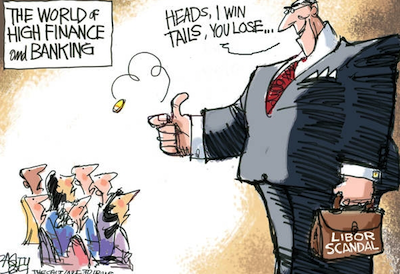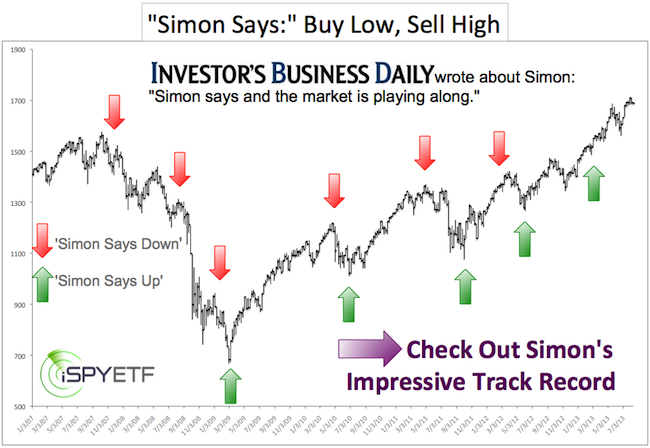According to an article by Rolling Stone, big banks control and manipulate financial instruments worth some $900 trillion. That's $900 trillion. For some perspective, the market cap of the Dow Jones (DJI: ^DJI) and S&P 500 (SNP: ^GSPC) is about $16 trillion each. The market cap of the S&P 500 financial sector (NYSEArca: XLF) is less than $3 trillion.
You’d think it requires unimaginable sophistication to pull off a heist like that, but apparently it’s easier done than said. Below is an excerpt from an exchange between a trader and Libor submitter at RBS (Royal Bank of Scotland):
Trader: can u put 6m swiss libor in low pls?...
Submitter: Whats it worth
Trader: ive got some sushi rolls from yesterday?...
Submitter: ok low 6m, just for u
Trader: wooooooohooooooo. . . thatd be awesome
How can grand financial theft be that easy?
In short, the players of the financial game set the rules of the financial game. For example, here is how Libor rates are set. Libor measures the prices banks charge one another to borrow money. About $500 trillion worth of financial instruments are linked to Libor.
Libor is based on how much the world’s biggest banks believe they would have to pay to borrow from a fellow bank. Every morning 18 big banks (called the Libor panel) submit their suggested rate to an office in London.
All submitted rates are averaged out and presented every morning at 11:30 London time as the daily Libor rates.
Britain’s Financial Services Authority uncovered hundreds of exchanges like the one above. Several big banks (NYSEArca: KBE) were fined. Barclays had to pay around $450 million, RBS $615 million and UBS $1.5 billion.
This monetary ‘slap on the wrist’ is all the government(s) did, but various towns, cities and investors filed their own anti-competitive collusion suit against big banks., but the suit didn’t get far.
Why? The banks and their attorneys argued that no one ever claimed that the Libor rate was competitive.

Furthermore, banks argued that they may have lied to or cheated their customers, but they weren’t guilty of antitrust collusion. The judge bought the argument and dismissed the case.
As you probably noticed, the Libor case is already in the rear view mirrow, but a new – nearly as big – cheating hot bed has emerged – ISDAfix.
ISDAfix is a benchmark used globally to calculate the price of interest-rate swaps. You may not have heard of ISDAfix before, but it’s a $379 trillion market.
The process of determining the ISDAfix rate is similar to that of the Libor rate, so there’s very real potential that rates were rigged, but the real problem is delayed reporting of the ISDAfix rates.
Delayed entering of the data gave banks the opportunity to trade ahead of information they probably already knew. Would banks take advantage of such an opportunity? Of course they would.
But wait, there is more. If you want to know how the government just reenacted a law that allows insider trading for Congress personael and exactly how much the Federal Reserve inflated stocks, look below.
The Shameless, Obvious & Unreported Cheating Tricks of Politicians & Wall Street - Part II or how the government makes Congress rich.
New York Fed Research Reveals That FOMC QE Drive S&P 500 XX% Above Fair Value
Simon Maierhofer is the publisher of the Profit Radar Report.
Follow Simon on Twitter @ iSPYETF or sign up for the FREE Newsletter.

|